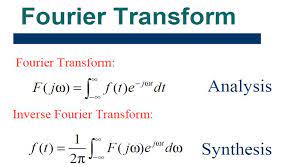One of the important approaches to solving a problem is choosing the right space dimension. As you can imagine, we cannot solve every problem in the space that we want.
However, one of the fascinating things about mathematics is that it allows us to switch between spaces. This mathematical expression, which we know as the Fourier Transform, allows us to solve a problem in another space if we cannot solve it in the space we want, and to return to the space we want with the Inverse Fourier Transform.
The Fourier Transform is a method that has physical real applications, not just abstract mathematics. For example, the Fourier Transform, which converts a signal in the time domain to the frequency domain, has applications in vibration analysis, image processing, sound engineering, etc.
On the other hand, if our problem takes discrete values, then what we need to apply is the Discrete Fourier Transform. Our famous space, Hilbert space, which is likely to come to your mind when you say discrete, may come to mind. Bingo! It is very possible to apply the Discrete Fourier Transform in the quantum world as well. So we now have a Quantum Fourier Transform method.
So what does the Quantum Fourier Transform do?
As you know, calculations in the quantum world are made on the basis of sets of 0 and 1. These are the situations that provide the transformation from computational bases to Fourier bases thanks to the Quantum Fourier Transform.
I will not go into the mathematical expression in this article, but in my next article, I will go into depth on this subject. Because, thanks to this method, which has an important place in quantum calculations, it forms one of the foundations of Shor's algorithm, which is its real application.
Stay curious :)
References
https://news.mit.edu/2012/faster-fourier-transforms-0118
https://ckk.com.tr/ders/signalssystems/SS%2060%20Fourier%20Transforms.pdf
https://deepai.org/machine-learning-glossary-and-terms/fourier-transform



Comments
Post a Comment